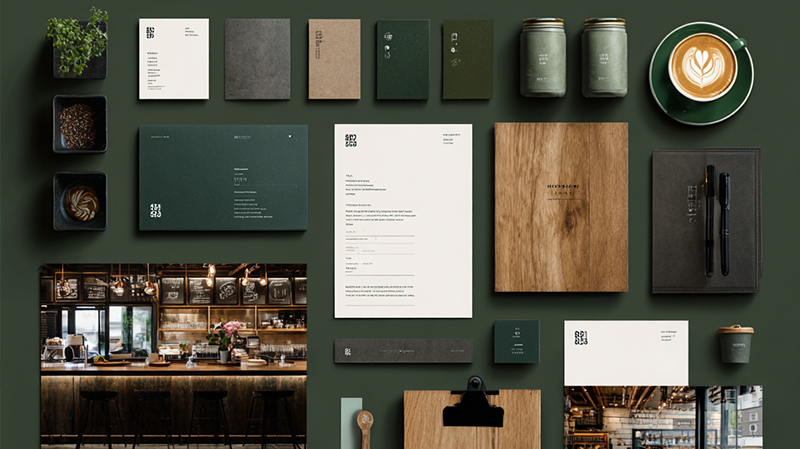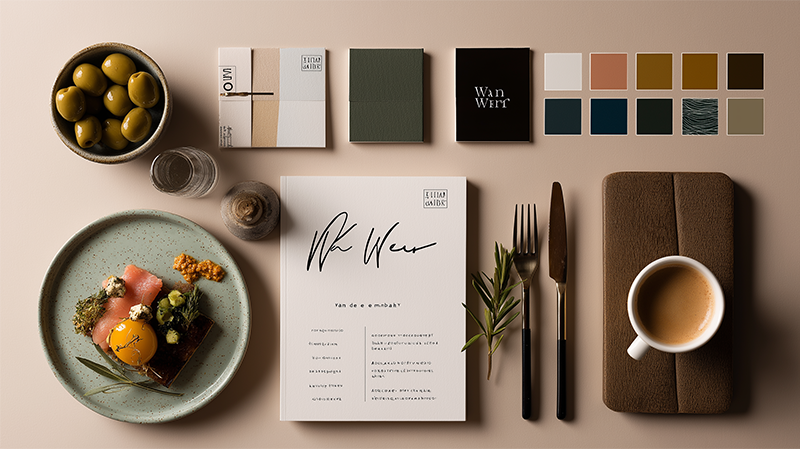Most restaurant owners think branding is just picking colors for their logo and posting pretty food photos on Instagram. I've watched hundreds of cafes, bars, and coffee shops pour thousands into "brand design" only to wonder why customers still can't remember their name or why their Google reviews sound like carbon copies of every other place down the street.
Here's what I've learned helping restaurants build memorable brands that actually drive revenue: your restaurant branding strategy isn't about what you say about yourself. It's about the specific feeling customers get when they think about coming back.
The $50,000 Logo That Nobody Remembered
Last year, I met a coffee shop owner who'd just spent $50,000 on a complete "rebrand." New logo, new colors, new signage, professional photography. The works.
Three months later? Still empty tables at lunch. Still struggling to get noticed on Google Maps. Still getting generic reviews like "food was good, service was fine."
The problem wasn't the logo. The problem was that their brand had no pulse. No personality. No reason for anyone to choose them over the Starbucks across the street or the trendy new cafe that just opened two blocks away.
Real restaurant branding strategy starts with one question: When someone's deciding where to eat, what specific thought makes them choose you?

Stop Building a Brand, Start Building a Habit
Most restaurants approach branding backwards. They start with visual identity and hope it creates customer loyalty. But the most successful restaurants I work with do the opposite. They build habits first, then let their brand reflect those habits.
Think about your favorite local spot. I bet you don't go there because of their Instagram aesthetic. You go because of something more specific: maybe they remember your order, maybe they're the only place that makes coffee exactly how you like it, or maybe they're where you feel comfortable working alone for hours.
That's not marketing. That's habit formation. And habits are what turn first-time visitors into regulars who leave five-star Google reviews and recommend you to friends.
Your restaurant branding strategy should focus on creating one specific habit you want customers to associate with your business. Not five habits. One. Make it so specific that when customers experience it, they think of you immediately.
The Three-Layer Brand System That Actually Works
After working with over 200 restaurants, cafes, and bars, I've noticed that memorable brands operate on three distinct layers. Most restaurants only focus on layer one, which is why their branding feels generic.
Layer 1: The Surface Experience (What Everyone Does)
This is your visual identity, your menu design, your social media posts. Important? Yes. Enough to differentiate you? Absolutely not.
Every restaurant thinks their food photos and color scheme will set them apart. Meanwhile, customers are scrolling past dozens of similar-looking posts every day. Your Instagram feed isn't your brand. It's just documentation of your brand.
Layer 2: The Functional Promise (What Smart Restaurants Do)
This is where you get specific about what experience you deliver consistently. Not "great food and service" (everyone claims that), but something measurable and ownable.
Maybe you're the coffee shop that guarantees your order will be ready in under three minutes during rush hour. Maybe you're the restaurant where solo diners never feel awkward because you've designed your space and service specifically for people eating alone. Maybe you're the bar where regulars can always count on seeing familiar faces because you've built community into your operating model.
Notice how specific these examples are? You can't fake consistency at this level. You have to operationalize it. Build it into your hiring, training, space design, and daily procedures.
Layer 3: The Emotional Foundation (What Legendary Restaurants Do)
This is the hardest layer to articulate, but it's what creates customers who become advocates. It's about understanding the deeper reason someone chooses to spend their limited time and money at your place instead of eating at home or going somewhere else.
Are you helping busy parents feel like they're treating their family to something special without the stress of cooking? Are you giving remote workers a place where they can be productive while feeling connected to their community? Are you creating a space where first dates feel comfortable and conversation flows naturally?
This layer isn't about what you do. It's about how your customers feel about themselves when they're with you.

Why Most Restaurant Marketing Fails (And How Branding Fixes It)
Here's something that might surprise you: restaurants with strong brands spend less on Google Ads and get better results. They show up higher on Google Maps without paying for it. Their social media posts get more engagement even with smaller followings.
Why? Because search engines and social media algorithms prioritize businesses that generate genuine engagement and repeat visits. When your brand is clear and compelling, customers interact with your content more meaningfully. They leave more detailed reviews. They visit more frequently. They tag you in their own posts.
This creates a compounding effect that no amount of ad spending can replicate. Strong brands don't just attract customers. They attract the right customers, who stay longer, spend more, and bring friends.
The restaurants struggling with Google Maps visibility and unpredictable foot traffic usually have the same underlying issue: their brand isn't memorable enough to create the consistent customer behavior that search engines and social platforms reward.
The 90-Day Brand Clarity Exercise
Most restaurant branding projects drag on for months because owners try to solve everything at once. Here's a more practical approach I use with clients who need to see results quickly.
Month 1: Document Your Current Brand Reality
Spend 30 days paying attention to how customers actually behave in your space. Not how you hope they'll behave, but what they actually do.
What do they order most? When do they come in? How long do they stay? What do they do while they're there? What do they say in their reviews? What questions do they ask your staff?
This isn't market research. It's brand archaeology. You're uncovering the brand that already exists, whether you intended it or not.
Month 2: Identify Your One Ownable Habit
Based on what you observed, choose one specific customer behavior you want to own completely. Something you can deliver consistently and that competitors would struggle to copy.
Maybe it's being the breakfast spot where busy professionals can get high-quality food without waiting. Maybe it's being the neighborhood bar where everyone knows each other's names. Maybe it's being the coffee shop where students can study for hours without feeling pressured to leave.
Test this hypothesis. Adjust your operations, service, and space to deliver this experience more consistently. Track whether customers respond the way you expected.
Month 3: Align Everything Else
Once you've proven you can deliver your chosen habit consistently, update everything else to support it. Menu descriptions, social media content, Google Business Profile, staff training, even your playlist.
This isn't about changing everything at once. It's about making sure every touchpoint reinforces the same core experience.
How AI Search Changes Restaurant Branding Forever
ChatGPT and Google's AI search results are fundamentally changing how customers discover restaurants. Instead of scrolling through lists of options, people are asking specific questions: "Where can I get work done while eating good breakfast food?" or "What's a good date restaurant that's not too loud?"
Generic brands won't survive this shift. When AI recommends restaurants, it needs specific, distinctive information to work with. If your brand is "good food and friendly service," you'll disappear from AI recommendations because that describes thousands of restaurants.
But if your brand is "the coffee shop where remote workers can reserve quiet tables and get unlimited coffee refills while working," suddenly you're the obvious answer when someone asks AI for workspace-friendly cafes in your area.
The restaurants that thrive in an AI-powered search world will be the ones with the clearest, most specific brand positioning. Not the loudest marketing or the biggest ad budgets.

Building Brand Equity That Shows Up in Your Bank Account
Strong restaurant branding isn't just about recognition. It's about pricing power. When customers see clear value in your specific brand promise, they're willing to pay more for it.
I've seen coffee shops increase their average ticket by 40% simply by clarifying their brand positioning and training staff to deliver on it consistently. Not by raising prices, but by helping customers understand why their experience was worth the current price.
Bars that brand themselves clearly around specific experiences (craft cocktails, sports viewing, live music, networking) can charge premium prices because customers know exactly what they're paying for.
Restaurants with strong brands also have more predictable revenue because they're less dependent on foot traffic and discounts. Their customers choose them intentionally, not just because they happened to be convenient.
Your Brand Isn't What You Say, It's What Customers Remember
At the end of the day, your restaurant branding strategy succeeds or fails based on one simple test: three months after someone visits your restaurant, what specific detail do they remember about the experience?
If they can't remember anything specific, you don't have a brand problem. You have a memorable experience problem. And no amount of marketing will fix that.
But if they remember something specific and positive, something that makes them want to come back or recommend you to a friend, then you have the foundation of a brand that can drive consistent growth.
The goal isn't to be everything to everyone. It's to be something specific to the right people. In a world where customers have unlimited dining options and increasingly short attention spans, specificity isn't just an advantage. It's survival.

-p-500.jpg)
